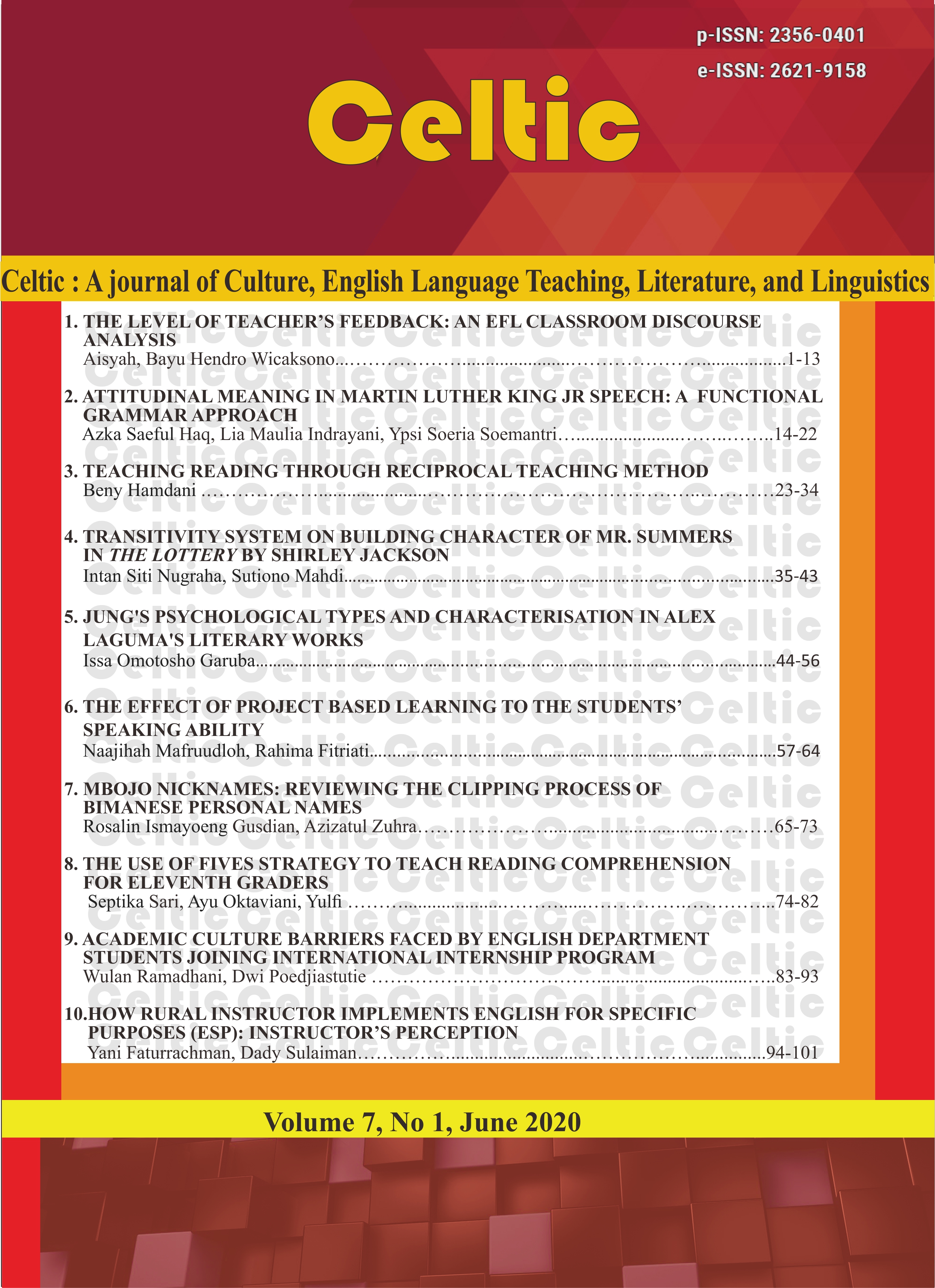JUNG'S PSYCHOLOGICAL TYPES AND CHARACTERISATION IN ALEX LAGUMA’S LITERARY WORKS
DOI:
https://doi.org/10.22219/celtic.v7i1.11427Keywords:
Psychoanalysis, Jung, Psychological Types, Characterisation, Narrative, LaGumaAbstract
Characterisation has immense influence on the study of literature, because it is as one of the determinants in measuring the quality of a narrative. Thus, assessing this aspect of a narrative, especially when dealing with characters in a racist narrative, requires an encompassing analytical approach. Hence, this paper is aimed atanalysing the psychological impulses that underlying the personality formations of the black characters in Alex La Guma’sA Walk in the Night and In the Fog of the Season’s End. In which, it adopts Carl Gustav Jung’s Psychological Types. The choice of this psychoanalytical tool is informed by the fact that, of all the psychological discoveries of Jung, the psychological types or the psychology of individuation has been acknowledged as his most significant discovery in psychoanalysis which has not attracted the literary critical attention, especially in terms of character analysis. To this end, therefore, the study attempts to establish the two categories of the reactions identified by Jung, namely introversion and extraversion, using the two Alex La Guma’sfictions.In addition, through the psychological complexities of the characters, ultimately, it is revealed that the extreme reactions are the products of individual innate tendencies, devoid of the social or the racial affiliations.
Downloads
References
Astrid, S.(2005). Psychoanalysis and apartheid: The image and role of a psychiatrist in selected works of Lewis Nkosi. Lindy Stiebel and Liz Gunner (Ed.), Still Beating the Drum: Critical Perspectives on Lewis Nkosi (pp. 92-102). New York: Rodopi.
Azizah, N., & Sudiran. (2015). A study on diglossia used by Helen Keller as the main characters in George Sullivan’s novels “Helen Keller”. Celtic: A Journal of English Language Teaching and Culture, 2 (3): pp. 1-18.
Babbie, R. E. &Mouton, J. (2001). The practice is social research. Oxford: Oxford University Press.
Bennett, A.&Royle, N.(2014).Introduction to literature, criticism and theory (3rded.).Harlow: Pearson.
Davenport, R.T. H. (1987).South Africa: A modern history.London: Palgrave Macmillan.
Denzin, N. K. & Lincoln, Y. S. (1994). Handbook of qualitative research. Thousand Oaks: Sage.
De Laszlo, V. S. (ed.) (1959). The basic writings of C. G. Jung. New York: Modern Library Press.
Garuba, I. O. (2019). Alienation and character typology in African American and Native American narratives: A Jungian reading of the bluest eye and winter in the blood. Prague Journal of English Studies, 8(1): pp. 55-75.
Jung, C. G. (1946). Psychological types. London: Kegan Paul.
--- (1972). Two essays in analytical psychology. New York: Princeton University Press.
Kennedy, X. J. &Gioia, D. (2007). Literature: An introduction to fiction, poetry, drama, and writing (Part 1 Fiction). New York: Longman.
Mowah, F. U. (1996). Psychology and African literature. Ibadan: Stirling-Horden.
Nwagbara, U. (2011).Arresting historical violence: Revolutionary aesthetics and Alex La Guma’s fiction. The Journal of Pan African Studies,4 (3): pp. 14-130.
Ogbeide, V. O. (2014).Oases in the desert: Optimistic vision in Alex La Guma’sa walk in the night and a threefold cord. Research on Humanities and Social Sciences, 4 (7): pp. 115-121.
Patton, M. Q. &Cochran, M. A guide to using qualitative research methodology. Medecins Sans Frontiers, 2002.
Pointer, F. H. (2011). A passion to liberate: La Guma’s South African-Images of District Six. Trenton, NJ: Africa World Press.
Sharp, D. (1987). Personality types: Jung’s model of typology. Toronto: Inner City Books.
Sommers-Flanagan, J.&Sommers-Flanagan, R. (2004). Counselling and psychotherapy theories in context and practice: Skills, strategies and techniques (2nd ed.). New Jersey: John Wiley & Sons, Inc.
Stevick, P. (ed.). (1967).The theory of the novel. New York: The Free Press.
Downloads
Published
How to Cite
Issue
Section
License
- Authors retain copyright to publish without restrictions and grant the journal right of first publication with the work simultaneously licensed under a Creative Commons Attribution License that allows others to share the work with an acknowledgement of the work's authorship and initial publication in this journal.
- Authors are able to enter into separate, additional contractual arrangements for the non-exclusive distribution of the journal's published version of the work (e.g., post it to an institutional repository or publish it in a book), with an acknowledgement of its initial publication in this journal.
- Authors are permitted and encouraged to post their work online (e.g., in institutional repositories or on their website) prior to and during the submission process, as it can lead to productive exchanges, as well as earlier and greater citation of published work.














